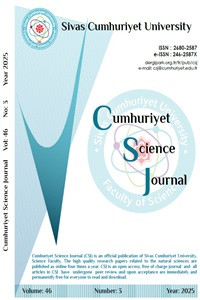Optical Properties of a Two-Stage Oppositely Rotated Liquid Crystal Retarder System: A Monte Carlo and Mueller Matrix Study
Abstract
We present a computational study of a two-stage liquid crystal (LC) retarder system composed of oppositely rotated planar-aligned LC layers placed between three linear polarizers. The molecular orientations of the LC molecules (LCMs) are modeled using Monte Carlo (MC) simulations based on the Lebwohl–Lasher and Rapini–Papoular potentials. The resulting director configurations are used as input for Mueller matrix-based optical analysis to compute polarization-dependent transmittance across the visible spectrum. We systematically explore the effects of rotation angle, cell thickness, and wavelength on the system’s transmission characteristics. Particular attention is given to red (700 nm), green (546.1 nm), and blue (435.8 nm) (RGB) light components, demonstrating polarization-sensitive spectral filtering and angular tunability. Our findings highlight the system’s potential for use in compact optical filters, RGB channel isolation, and polarization-sensitive imaging applications.
Keywords
Monte Carlo simulation liquid crystal retarder polarization optics Mueller matrix tunable optical filter birefrengence
References
- [1] Woltman S. J., Jay G. D., Crawford G. P., Liquid-crystal materials find a new order in biomedical applications, Nature Materials, 6 (12) (2007) 929-938.
- [2] Sneh A., Johnson K. M., High-speed continuously tunable liquid crystal filter for WDM networks, Journal of Lightwave Technology, 14 (6) (1996) 1067-1080.
- [3] Berlic C., Barna V., Monte Carlo simulation of the molecular distribution and optical properties of a nematic liquid crystal system with periodic surface gratings, Opt. Express, 18 (23) (2010) 23646–23656.
- [4] García-García A., VergazR., Algorri J. F., Quintana X., Otón J. M., Electrical response of liquid crystal cells doped with multi-walled carbon nanotubes, Beilstein Journal of Nanotechnology, 6 (1) (2015), 396-403.
- [5] Lebwohl P. A., Lasher G., Nematic-Liquid-Crystal Order---A Monte Carlo Calculation, Phys. Rev. A, 6 (1) (1972), 426-429.
- [6] Emül Y., Monte carlo simulations for tuning optical properties in a two-stage liquid crystal retarder system via Mueller matrix method, Liquid Crystals, (online) (2024) 1-8.
- [7] Emül Y, Polat Ö., San S. E., Kayacan Ö. Özbek H., Investigating electro-optical properties of a nematic liquid crystal cell with planar anchoring boundary condition for various thicknesses: A Monte Carlo study, Optical Materials, 36 (8) (2014) 1373-1377.
- [8] Xu F., Kitzerow H. S., Crooker P. P., Electric-field effects on nematic droplets with negative dielectric anisotropy, Phys. Rev. A, 46 (10) (1992) 6535–6540.
- [9] Goldstein D. H., Polarized light, CRC Press, (2011) 50-134.
- [10] Aharon O., Abdulhalim I., Liquid crystal Lyot tunable filter with extended free spectral range, Opt. Express, 17 (14) (2009) 11426–11433.
- [11] Lagerwall J. P. F., Scalia G., A new era for liquid crystal research: Applications of liquid crystals in soft matter nano-, bio- and microtechnology, Current Applied Physics, 12 (6) (2012) 1387-1412.
- [12] Sigaki H. Y. D., de Souza R. F., de Souza R. T., Zola R. S., Ribeiro H. V., Estimating physical properties from liquid crystal textures via machine learning and complexity-entropy methods, Phys. Rev. E, 99 (1) (2019) 013311.
- [13] Pieprzyk S., Yevchenko T., Dardas D., Brańka A. C., Phase transitions and physical properties by a color texture analysis: Results for liquid crystals, Journal of Molecular Liquids, 362 (2022) 119699.
- [14] Hwang D. K., Rey A. D., Computational modeling of the propagation of light through liquid crystals containing twist disclinations based on the finite-difference time-domain method, Appl. Opt., 44 (21) (2005) 4513–4522.
Details
| Primary Language | English |
|---|---|
| Subjects | Atomic, Molecular and Optical Physics (Other), Classical and Physical Optics |
| Journal Section | Natural Sciences |
| Authors | |
| Publication Date | September 30, 2025 |
| Submission Date | July 11, 2025 |
| Acceptance Date | September 15, 2025 |
| Published in Issue | Year 2025 Volume: 46 Issue: 3 |

